![]()
![]()
![]()
Use LEFT and RIGHT arrow keys to navigate between flashcards;
Use UP and DOWN arrow keys to flip the card;
H to show hint;
A reads text to speech;
20 Cards in this Set
- Front
- Back
- 3rd side (hint)
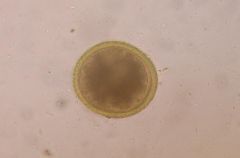
|
Toxocara Canis Common Name: Dog Roundworm Definitive Host: Dog Direct or Paratenic Host Diagnose: Eggs in feces Tx: pyran, fenbendazole, can treat with fenbendazole when pregnant Can have transplacental transmission and will use ivermectin to attempt preventing puppies from getting roundworms; larvae can live in soil; transmammary transmission; lives in small intestine Prepatent period: 2-4 weeks Under microscope: inside is dark; egg-shaped (round) & outside shell is thick and pitted |
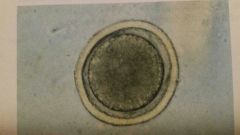
|
|
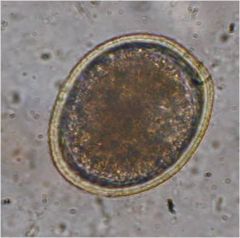
|
Toxocara Cati Common Name: Cat Roundworm Definitive Host: Cat Direct Life Cycle or have Paratenic Host Cat sheds it on the ground and ingests it back into its system Diagnose: Eggs in feces or adults in vomits Tx: Pyran, Fenbendazole, Moxidectin, Milbemycin Oxime, Selamectin Prepatent Period: 8 weeks Larvae can live in soil; Trachealmigration if ingested from the ground; lives in small intestine; may cause vomit; do not attach to stomach wall; free swimming; transmitted transmammally |
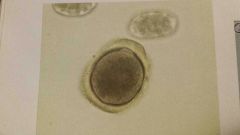
|
|
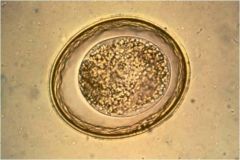
|
Toxascaris Leonina Common Name: Roundworm Definitive Host: Dog & Cat Direct Life Cycle Diagnose: eggs in feces Tx: Fenbendazole, Moxidectin, Pyran, Milbemycin Oxime Prepatent Period: 8-10 weeks Become infected fast; Animal won't show signs; Primarily found in adult animals; not known of until fecal is completed Looks like an eyeball under the microscope; not dark in appearance; large oval Zoonotic: most common zoonotic disease of children; referred to as visceral larval migrans; causes eosinophilia; obtained by ingestion of soil |
|
|

|
Ancylostoma Caninum, Common Name: Hookworks Definitive Host: A. caninum = dogs, A. tubaeforme = cats, A. brazillience = cats and dogs, U. Stenoccephala = (northern canine hookworms) found in dogs Direct Life Cycle or Paratenic Host Diagnosed: Eggs in feces Tx: Fenbendazole, Pyran, Moxidectin Found in small intestine; ingest larvae from soil and larvae can penetrate skin of host or by paratenic host; If penetrate skin, will undergo tracheal migration; they all attach to the intestinal wall and suck blood; inject anticoagulant to keep blood flowing but worm doesn't stay in one place causing the animal to become real sick; adult worms live in the intestinal tract for 4-24 months |
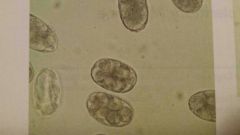
|
|
|
Hookworms are... |
Zoonotic: causes cutaneous larval migration, serpentine lesions in skin, intensely pyretic, skin penetration, common in southeast and warmer states, "plumbers itch" |
|
|
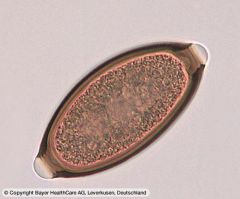
|
Trichuris Vulpis Common Name: Whipworm Definitive Host: Dogs, Foxes, Coyotes (2 others: Trichuris Campanula: rarely in cats; Capillaria spp. Dogs and cats) Direct Life Cycle Adults found in secum & colon in ground for 3-5 years Prepatent Period: 3 months Most anthomynics only kill adult worms so we must do once a month dewormer for 3 months (usually fenendazole) if known whipworms; most likely anemia is caused Under microscope: Bipolar plugs, football shaped, pretty yellow/orange color |
|
|
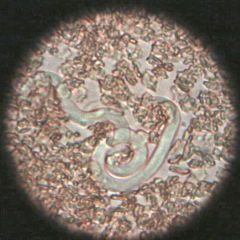
|
Dirofilaria Immitis Common Name: Heartworms (adults in right ventricle and pulmonary arteries; can be abarent) Definitive Host: Dogs, cats, ferrets Indirect Lifecycle; Intermediate Host = Mosquitos Diagnose: microfilaria in blood, commercial/antigen tests, PCV testing Tx: 2 injections of amiticide 24 hours apart into epaxial muscles Prepatent Period: 6-8 months Adult animals will have Ascites (accumulation of fluid in abdomen looks like pot belly) Mosquito bites dog; dog has heartworms and mosquito picks up immature larvae which develop in their mouth parts; L3 (infective stage) it bites another animal which is injected into the animal's system. It circulates, becomes L4, and gets to heart to become L5. It takes 2 weeks to go from L1 to L3. |
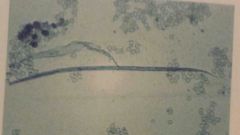
|
|
|
Heartworms in cats |
Occult(adult worms but no microfilaria) heartworm infections are possible 90% in cats and 25% in dogs. If a cat tests negative, do not assume the cat is negative. No treatments for cats. Most of the time it's migrating microfilaria that kills the cat. 90% because of bigger immune response; don't cause pulmonary damage like in dogs; can be misdiagnosed as asthma; HARD - Heartworm Association Respiratory Disease |
|
|
|
Define Occult Heartworms |
All same sex = no microfilaria Body can mount immune response, as microfilaria reach body, immune can kill off microfilaria Ivermectin given orally: kills microfilaria but test is positive |
|
|
|
Dirofilaria immitis in humans |
the worm ends up in the lungs where it curls up and dies because we aren't hosts for the worm |
|
|
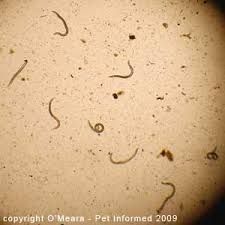
|
Aelurostrongylus abstrusus Common Name: lungworm Definitive Host: cat Indirect: Host = snail or slug Signs: Coughing, wheezing, dyspnia, gray nodules on lungs Diagnosis: Larvae in fecal or baerman technique Tx: Fenbendazole, ivermectin |
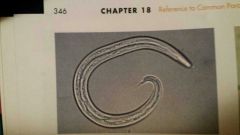
|
|
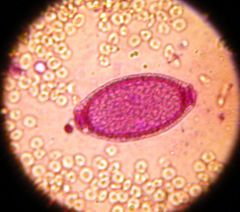
|
Capillaria plica/Pearsonema plica Common Name: Bladder worm Definitive Host: Dogs & Cats Found in bladder and ureters Indirect: Host = earthworms Asymptomatic or urinating abnormalities Diagnosis: Eggs in urine Tx: Lavamisole, Fenbendazole, Albendazole, Ivermectin |
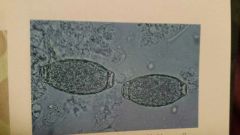
|
|

|
Dipylidum caninum Common Name: Flea tapeworm Definitive Host: Dogs and cats Indirect: host = fleas, biting lice Diagnosis: segment on feces, egg packets rarely seen in feces Infective - cysticercoids Tx: epsipantel, prazquantel Zoonotic |

|
|

|
Taenia pisiformis Common Name: -tapeworm Definitive Host: dogs and cats Indirect: host = rabbits Infective stage: cystacercus in rabbit meat tends to be in live and peritoneal tissue |

|
|
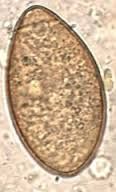
|
Spirometra mansonoides Commonly known as: zipper tapeworm Definitive Host: Dogs & Cats Zipper-like because it opens, releases eggs, and zips itself back up; found in Florida and Gulf Coast Indirect host: fish & amphibians Diagnosis: Eggs in feces Infective Stage: Plerocircoid Zoonotic |
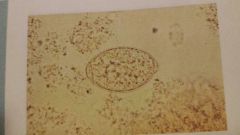
|
|
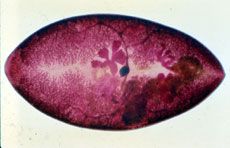
|
Paragonimus kellicotti Common Name: Lung Fluke Definitive Hosts: Dogs & Cats Indirect host: Crayfish Found in lungs Diagnosis: Eggs in feces or sputum Infective stage: metacercariae in crayfish Can see adults and cysts in lungs with radiograph |
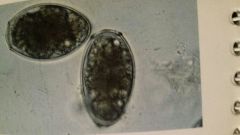
|
|
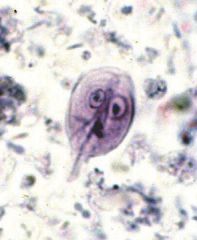
|
Giardia in cats and dogs Common Name: Giardia Definitive Hosts: Cats and Dogs Direct Life Cycle Causes diarrhea in the animal; often called "Monkey face" because of motile feeding stage called trophazoa; ingested from bad food or H2O develops in intestinal tract, made to cysts, and shed in feces Diagnosis: Cyst in feces or seeing motile filaria with zinc sulphate floatation solution Tx: fenbendazole for dogs metrinidazole for cats |
|
|
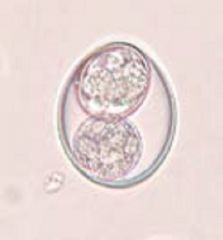
|
Cystoisospora spp. Common Name: Coccidia Definitive Host: dogs & cats Direct: contaminated food and water Diagnosis: oocysts in feces Infective Stage: sporulated oocyst Causes diarrhea; poor housing condition; loose to watery yellow diarrhea; can be tinged with blood Diagnosis: Shows in fecal and shows signs; will not treat until shows signs Tx: Albon |
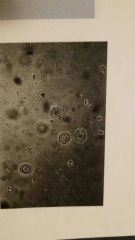
|
|
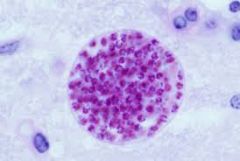
|
Toxoplasma gondii Definitive Host: Cat but almost any warm-blooded mammal can be infected Direct Diagnosis: Oocysts on fecal but can't be differentiated from other oocysts Infective Stage: Ingestion of sporulated oocysts Takes 1-5 days for oocysts to sporulate Tx: sulfanomide drugs |
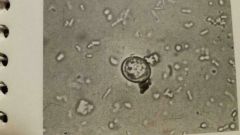
|
|
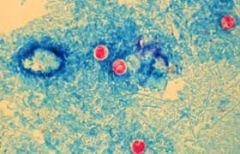
|
Cryptosporidium spp. Definitive Host: Dogs and cats Direct Diagnosis: Oocysts in floatation Tx: Tylosine |
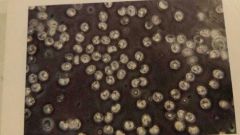
|

